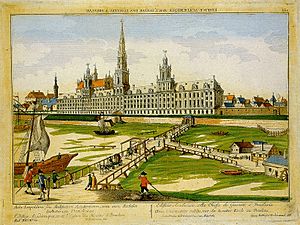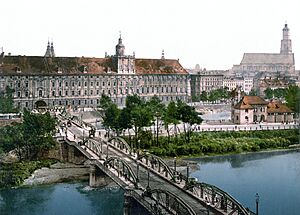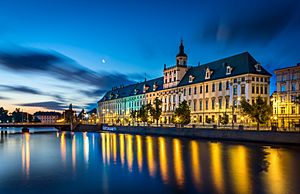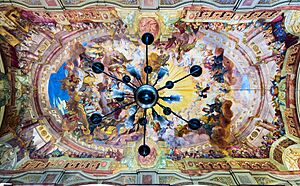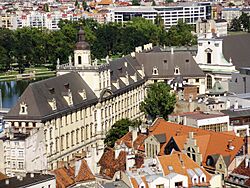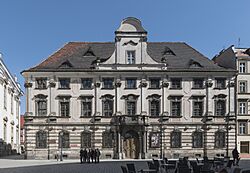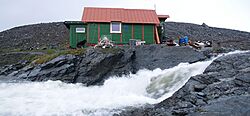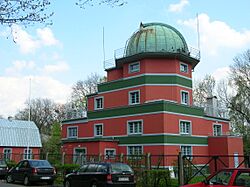University of Wrocław facts for kids
|
Uniwersytet Wrocławski
|
|
 |
|
| Latin: Universitas Wratislaviensis | |
|
Former names
|
German: Leopoldina, Universität Breslau, Schlesische Friedrich-Wilhelms-Universität zu Breslau (before 1945) |
|---|---|
| Type | Public |
| Established | 21 October 1702 (reorganised 1945) |
| President | Robert Olkiewicz |
|
Administrative staff
|
3,569 |
| Students | 20,293 (12.2023) |
| Location | , , |
| Campus | Urban |
| Colors | Blue |
The University of Wrocław (called Uniwersytet Wrocławski in Polish) is a big public university in Wrocław, Poland. It is a place where students go to learn and researchers work on new discoveries. It is the largest university in the Lower Silesian Voivodeship region.
Since 1945, over 100,000 students have graduated from this university. Many of its researchers have won important awards for their scientific work. The university was re-established in its current form in 1945. It took over from the German University of Breslau. After World War II, professors from the Jan Kazimierz University in Lviv helped rebuild the university. The buildings were badly damaged during the Battle of Breslau in 1945.
Contents
History of the University
Early Beginnings: Leopoldina
The idea for a university in Wrocław goes back a long time. In 1505, King Vladislaus II of Hungary of Poland tried to start a school called Generale litterarum Gymnasium. However, this plan did not work out. The Pope said no for political reasons. Also, many wars and opposition from the Jagiellonian University in Kraków stopped it.
The first successful start happened much later, in 1702. Holy Roman Emperor Leopold I signed a special document. This document officially created the university. It was named Leopoldina after him.
Before becoming a university, the buildings were used as a Jesuit school since 1638. In 1702, Emperor Leopold I turned it into a university. It focused on philosophy and Catholic theology. The university opened on November 15, 1702. It was a Catholic school in a mostly Protestant city. This made it important for the Catholic Church in the region. Later, when Silesia became part of Prussia, the university changed. It still taught Catholic clergy but lost some of its earlier purpose.
Changes and Growth: Silesian Friedrich Wilhelm University
After Napoleon defeated Prussia, the Prussian state was reorganized. In 1811, the Leopoldina university joined with the Protestant Viadrina University. This university was previously in Frankfurt (Oder). The new combined university was called the Königliche Universität zu Breslau. In 1911, it was renamed the Schlesische Friedrich-Wilhelms-Universität zu Breslau. This was to honor its founder, Frederick William III of Prussia.
At first, the university had five main study areas: philosophy, medicine, law, Protestant theology, and Catholic theology. Over time, it grew a lot. It added many different scientific institutes and clinical centers. By 1884, the university had 1,481 students and 131 teachers.
The university's library was very large. In 1885, it had about 400,000 books. These books came from other old universities and monasteries. The university also had an observatory and a five-hectare botanical garden. There was also a natural history museum and various scientific collections.
Many famous scholars taught at the University of Breslau in the late 1800s. These included Peter Gustav Lejeune Dirichlet, Ferdinand Cohn, and Gustav Kirchhoff.
The university was a diverse place. In 1817, about 16% of the students were Polish. By the late 1800s, about 10% were Polish and 16% were Jewish. These groups, along with German students, formed their own student clubs. Polish student groups included Concordia and Polonia. Jewish student groups were Viadrina and the Student Union.
As Germany moved towards a harmful political idea called Nazism, the university was affected. Polish students faced unfair treatment. In 1939, all Polish students were forced to leave. The university even declared that no Polish person would ever study there again. During World War II, some German scholars from the university worked on ideas to justify German control over Polish lands. They also tried to present cities like Kraków as German.
In January 2015, the university did something important. It gave back 262 PhD degrees that were taken away during the Nazi period. These degrees belonged to Jewish scholars and others who were seen as against the Nazi ideas.
Rebirth: University of Wrocław
After the Siege of Breslau, the city was taken by the Red Army in May 1945. Breslau became part of Poland and was renamed Wrocław. The first Polish academics arrived in Wrocław in May 1945. They took over the university buildings, which were 70% destroyed. Some books from the university library were lost or burned during the fighting in 1945.
| University rankings | |
|---|---|
| Global – Overall | |
| CWTS World | 710 |
| QS World | 801–1000 |
| THE World | 801–1000 |
| USNWR Global | 833 |
| Regional – Overall | |
| QS Emerging Europe and Central Asia | 49 (2022) |
Workers quickly repaired some buildings. Many new professors came to Wrocław, especially from the pre-war Polish Jan Kazimierz University in Lwów and Stefan Batory University in Wilno. After the war, many people from these areas moved to Wrocław. By mid-1948, over 60% of professors at Wrocław University were from these eastern Polish regions. Stanisław Kulczyński from the University of Lwów became the first president of the new Polish universities in Wrocław.
The University of Wrocław was officially re-established as a Polish state university on August 24, 1945. The first lecture was given on November 15, 1945. Between 1952 and 1989, the university was named after Bolesław Bierut, a Polish leader at the time.
In 2015, the university restored academic degrees that were taken from German Jews by the Nazis. This happened almost 80 years after the degrees were stripped. The university believes about 262 people were affected this way.
What Can You Study?
The University of Wrocław has 10 main departments, called faculties. These faculties offer 44 different areas of study. Most classes are taught in Polish, but some are in English. The university offers Bachelor's, Master's, and Doctoral degrees. Degrees from the University of Wrocław are recognized all over the world.
Here are the faculties:
- Faculty of Biotechnology
- Faculty of Chemistry
- Faculty of Philology (which studies languages and literature)
- Faculty of Physics and Astronomy
- Faculty of Mathematics and Computer Science
- Faculty of Biological Sciences
- Faculty of History and Pedagogy (which studies teaching)
- Faculty of Earth and Environmental Sciences
- Faculty of Social Sciences
- Faculty of Law, Administration and Economics
University Leaders (Rectors)
A rector is the main leader of a university. Here is a list of the rectors of the University of Wrocław since 1945:
- Stanisław Kulczyński (1945–1951)
- Jan Mydlarski (1951–1953)
- Edward Marczewski (1953–1957)
- Kazimierz Szarski (1957–1959)
- Witold Świda (1959–1962)
- Alfred Jahn (1962–1968)
- Włodzimierz Berutowicz (1968–1971)
- Marian Orzechowski (1971–1975)
- Kazimierz Urbanik (1975–1981)
- Józef Łukaszewicz (1981–1982)
- Henryk Ratajczak (1982–1984)
- Jan Mozrzymas (1984–1987)
- Mieczysław Klimowicz (1987–1990)
- Wojciech Wrzesiński (1990–1995)
- Roman Duda (1995–1999)
- Romuald Gelles (1999–2002)
- Zdzisław Latajka (2002–2005)
- Leszek Pacholski (2005–2008)
- Marek Bojarski (2008–2016)
- Adam Jezierski (2016–2020)
- Przemysław Wiszewski (2020–2022)
- Robert Olkiewicz (since 2022)
Famous People Connected to the University
Many notable people have studied or worked at the University of Wrocław. Here are some of them:
- Albert Wojciech Adamkiewicz
- Adolf Anderssen
- Adam Asnyk
- Grzegorz Braun
- Ruth Baum
- Mateusz Morawiecki
- Paweł Marchewka
- Kamil Bortniczuk
- Robert Bunsen
- Florian Ceynowa
- Hans Cloos
- Stephan Cohn-Vossen
- Jan Dzierżon
- Norbert Elias
- August von Fallersleben
- Heinz von Foerster
- Heinz Fraenkel-Conrat
- Gustav Freytag
- August Froehlich
- Otto von Gierke
- Adolph Eduard Grube
- Fritz Haber
- Siegmund Hadda
- Clara Immerwahr
- Otto Jaekel
- Jan Kasprowicz
- Paweł Kempka
- Gustav Kirchhoff
- Bronisław Knaster
- Adolf Kober
- Wojciech Korfanty
- Urszula Kozioł
- Waldemar Kozuschek
- Marek Krajewski
- Emil Krebs
- Moshe Kunitz
- Otto Küstner
- Hans Lammers
- Ferdinand Lassalle
- Kurt Lischka
- Jan Łopuszańki
- Michaelis Machol
- Kazimierz Marcinkiewicz
- Edward Marczewski
- Antoni Matuszkiewicz
- Henry J. Messing
- Gustav Meyer
- Julius Lothar Meyer
- Jan Mikusiński
- Jan Miodek
- Karol Modzelewski
- Jan Mycielski
- Jan Noskiewicz
- Barbara Piasecka Johnson
- Stanisław Potrzebowski
- Jan Evangelista Purkyně
- Eugen Rosenstock-Huessy
- Friedlieb Ferdinand Runge
- Wojciech Samotij
- Joseph Schacht
- Rudolf Schnackenburg
- Karel Slavíček
- Władysław Ślebodziński
- Karl Slotta
- Edith Stein (Saint Teresa Benedicta of the Cross)
- Charles Proteus Steinmetz
- Hugo Steinhaus
- Otto Stern
- Paul Tillich
- Carl Wernicke
- Mieczysław Wolfke
- Seweryn Wysłouch
- Johannes Zukertort
Honorary Doctorates
See also
 In Spanish: Universidad de Breslavia para niños
In Spanish: Universidad de Breslavia para niños
- Wrocław University of Technology
- List of early modern universities in Europe
- List of Jesuit sites
- Academic Festival Overture


